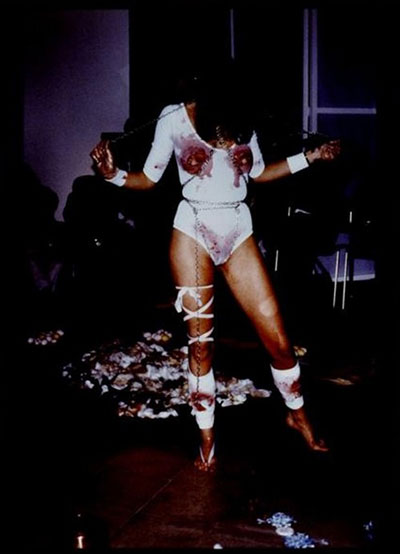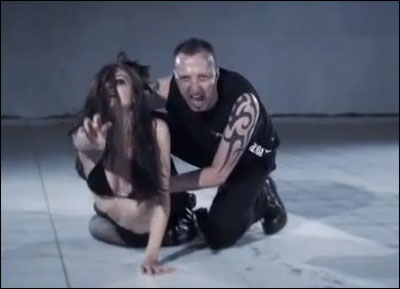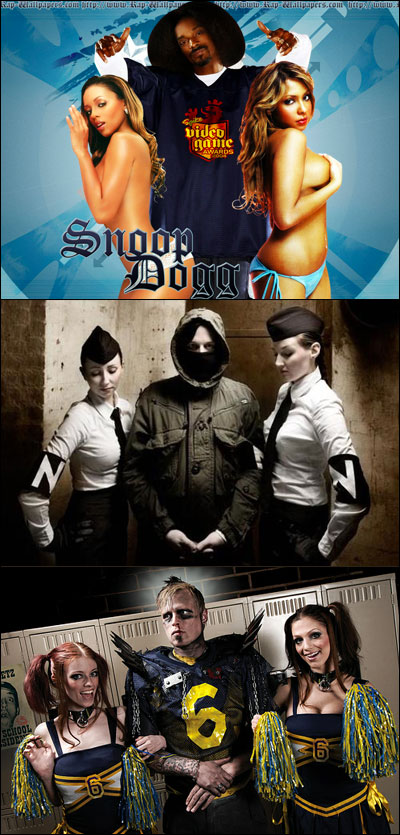On Misogyny in Industrial Music

Industrial music patron saint Cosey Fanni Tutti.
In 1975, Genesis P-Orridge and Cosey Fanni Tutti consumed blood, semen and piss onstage in the UK. Government officials labeled them “the Wreckers of Civilization.” A female sex worker, Cosey examined “how men and women interact in a sexually charged/volatile manipulated situation” by fearlessly, shockingly putting her body on display. This was the beginning of industrial music, a genre rooted in taboo and transgression.
The tradition continued. In 1985, Coil’s cover of Tainted Love addressed the AIDS crisis at a time when huge stigma still surrounded the discussion. The release of the single constituted the first AIDS benefit in music history. In 1988, Skinny Puppy spoke out passionately about animal rights through a series of live shows that involved animal blood and graphic, distressing portrayals of vivisection. During the Siege of Sarajevo in 1995, Laibach’s NSK diplomatic passports literally saved lives by enabling people to escape from the war zone at a time when Bosnian passports weren’t considered valid. The giants of industrial used subversive tactics to challenge audiences and create new awareness.

Still from Suicide Commando’s “Die Motherfucker Die” music video
But something happened. Once industrial music had fully transitioned from avant-garde venues into nightclubs, the stench of Axe body spray began to dominate the subculture as a certain douchey, bro-tastic vibe emerged. Where the goth/industrial scene had once existed as a safe haven for artists, weirdos, outcasts, geeks, dreamers and rebels, a disturbing trend of sexism, racism and anti-intellectualism is driving people out.
This trend gained significant traction in 2011. That March, Combichrist, a band infamous for songs such as “Shut Up and Swallow” and lyrics such as “all you feminist cunts you know that you want it”, released a music video called Throat Full of Glass, in which band members force captive gangster girls to strip at gunpoint before using them as human shields during a shootout. Similarly, Nachtmahr’s Can You Feel the Beat shows a bevy of interchangeable, uniformed, corseted lady soldiers at the beck and call of the solo musician, Thomas Rainer, who is styled after Downfall Hitler (minus the cheeky humor of Hipster Hitler or the high-art totalitarian whatthefuckery of Laibach). After one of his officers is captured by a Middle Eastern-looking villain (way to mix your shitty metaphors!), she is interrogated and beaten savagely. Then, a bag is placed over her head and she is “seduced” by the villain’s henchwomen into changing allegiances. After her rescue and return to Nachtmahr HQ, she is killed after the Nachmahr character suspects her of betrayal. (A scathing analysis of the entire music video can be found here).
But the rapey, murdery vibe isn’t limited to these two bands. Faderhead’s 2012 music video Fistful of Fuck You features an arcade game that lets the main character eliminate drag queens. In Suicide Commando’s 2009 Die Motherfucker Die, an aging Johan Van Roy spends the majority of the video alternately dragging scantily-dressed girls across the floor while they kick and scream, or sitting in a dirty bathtub surrounded by female corpses. Rammstein (who, in the past, have created more thoughtful fare) recently did a photo series with Eugenio Recuenco in which naked women are dismembered and eaten. And the ever-classy Hocico has a song called Ladykiller (Don’t Rape the Dead Girl).
No wonder women in the industrial scene report feeling marginalized, ridiculed, sexualized and disrespected. In an email interview with Coilhouse, Amelia Arsenic of industrial band Angelspit writes, “I feel the bands that are very popular in industrial at the moment mainly comprise of pretty bro-ish dudes singing about ‘manly’ things like guns and being violent with girls.” Like many of her compatriots in this music scene and others, Amelia says that she’s commonly mistaken for a merch girl or the girlfriend of somebody in the band. “One thing I’ve noticed is that I get a lot of questions from guys asking me if I know anything about the technical side of music. Most people think the guys do the writing and the girls just sing!” In Amelia’s video tutorial on semi-modular synths, the number of sexual/disparaging comments is high… even for YouTube.
Recently, two bands – Ad·ver·sary and Antigen Shift – decided to speak out against this growing trend. They did so by calling out two of the scene’s worst offenders while opening for them at Canada’s largest industrial festival, Kinetik. Above is the video that they played at the end of their set, right before Combichrist and Nachtmahr took the stage. Thoughtful criticism of this phenomenon already existed, but no one had ever conveyed the message so loudly and clearly, to the audience that most needed to see it. The “We Demand Better” video spread across the web like wildfire. “THIS.” “So on point.” “Thank you for making this”, wrote male and female industrial fans. Others accused Jairus Khan, the creator of the video, of trying to bolster his band’s popularity, describing the video as “overly PC,” or stating that Khan lacks a healthy sense of humor.
Both Andy LaPlegua from Combichrist and Thomas Rainer from Nachtmahr responded to the critique with interviews (here and here). In each instance, the musicians explained that the videos were made from the perspective of invented characters. “In Combichrist, for my sake, I always did it as a fictional character,” LaPlegua said. “I’m doing horror stories with Combichrist … it was meant as some kind of a parody, and little bit of irony.” Similarly, Thomas Rainer said in an interview, “my stage persona is the Supreme Commander. He’s very arrogant and cocky. I’m not like that at all, I’m a fun loving guy, I like to be social.”

For the sake of context, a similar technique is currently employed by rapper Nicki Minaj, who has long been criticized for her own misogynistic lyrics. Minaj has invented a character named Roman Zolanski, a boy who lives inside her head. Roman is responsible for all of Nicki’s most controversial lyrics, and she says she wishes for him to “go away.” As the The Lilith Effect puts it, “this is apparently supposed to absolve her of any and all responsibility for the damaging, derogatory language she uses while ‘Roman’ is speaking. Unfortunately, this tactic is no more honest and effective than a child blaming a broken vase on her imaginary friend.”
On the other hand, for some artists, remaining faithfully “in character” yields output and situations that can only be described as high art! Laibach – a band that “drew the attention and admiration of left-wing intellectuals and skinheads alike” and hasn’t broken character in over 30 years of interviews, ambiguously stating that they are “as much fascists as much as Hitler was a painter” – was able to create moments like the following 1996 concert, described in an essay by Erin Felicia Labbie:
Together with my budding and pseudo left-wing intellectual graduate school cohort, I rubbed shoulders with the enemy—the skinheads (who would have happily burned me at the stake in other contexts)—and found that, in the proper situation (entranced by music that they liked), they were quite nice, making room for intellectuals carrying beers, and even offering to light a cigarette here and there. Again, we asked, was this the power of the band to pacify violent skinheads by way of their sheer insight into the way that music may alter human emotion and affect? Or, were skinheads actually nice people despite their hatred, racism, anti-Semitism, anti-feminism, and xenophobia? … This, ten years ago, symbolized the utter perversity of the potential for artistic and textual interpretation itself.

Laibach playing four-player chess.
What makes a caricature acceptable, or a stage persona effective? Is it possible to read Combichrist and Nachtmahr’s work as satire? Does the format of the art – music versus film – make a difference? In three three different interviews, Andy LaPluega likens himself to film director Wes Craven. “Nobody would criticize Wes Craven for making The Hills Have Eyes, with a mutant raping some daughter. None of my stuff even gets close to being as mean and brutal as that, but nobody’s going to give him shit for it because it’s a movie,” LaPluega said in 2010. So Andy, if you’re blissfully unaware that film criticism is a thing, then good for you. As for Wes Craven? Here was his experience before going on to direct Scream 4, which has been described as “the first mainstream feminist horror movie”:
When I made Swamp Thing, my daughter was watching it with me, and I had a scene where a female character was running away, and as in all such situations in horror movies, she stumbled and fell. My daughter turned to me and said, “Dad, girls don’t always fall down.” This made me realize I had fallen into the old horror cliché of the girl running from the villain and tripping on a rock or some other debris. I didn’t really care for that, so it got me thinking about taking it in the other direction and creating some strong female characters.
The fact is, the world is changing, audiences are getting smarter, and people (especially the new generation coming of age online) are expecting more. We live in a world where 13-year-olds deconstruct slut-shaming on YouTube, and teens like Tavi Gevinson are leading a new wave of sassy, media-aware publishing. A world where more and more people know that “girls don’t always fall down,” and mock those who invoke that image.
The “cinematic reference” argument seems to be a common tactic in deflecting criticism. Thomas Rainer has used the filmic term “sexploitation” to describe Nachtmahr, and Throat Full of Glass music video director, Chad Michael Ward, wrote to Coilhouse stating that “the video, conceived by both the band and myself, is a send-up of 1970s grindhouse/exploitation films, where men were thugs and women were whores; in other words caricatures, not entirely unlike the noir films of the 1930s that I also love dearly.” In reality, the “it’s an homage to grindhouse” defense is so common that it’s becoming a cliche. Here’s the thing: when Tarantino revived the grindhouse genre, it was with clever, self-aware, satirical, intelligent scripts that actually told new stories that were relevant to our time. The Bride is one of the most celebrated bad-ass film icons out there. Similarly, today’s burlesque movement revives the noir glamour of the 30s with a DIY, feminist sensibility. Contrasted to that, what collective story does the combination of these industrial music videos tell?
Rainer also defends Nachtmahr by pointing out that he’s the producer and main songwriter for L’Âme Immortelle, “one of Europe’s most important female fronted goth/industrial bands.” While L’Âme Immortelle deals with Rainer’s “more feminine side as a musician” by projecting more “introvert, romantic and sensitive content,” Nachtmahr is the channel for his “masculine side of being extrovert, aggressive and direct.” So your two music projects reinforce the opposite aspects of the same tired, restrictive gender binary. Good job.

Combichrist fan art on DeviantArt. “Slut” by LuceInsana. “Rain of Blood” by Cantique. “Combichrist Fan” by Dita69. “Shut up and swallow” by SeparateFromTheHead.
That said, context is key. It’s interesting to note that it was the female cast who came up with and really enjoyed performing the most violent scenes in Combichrist’s TGoF. Do the critical standards change if we repackage these industrial music videos as straight-up BDSM porn? Sure! Industrial and fetish scenes share a long history together, and many of the same motifs – bondage, uniforms, blood, and control – appear in both. In his defense of Can You Feel the Beat, Thomas Rainer explains: “I’m … fulfilling a sexual fantasy of mine. I just get fucking turned on by hot chicks in uniforms. If I can have that in my band, it really turns me on, and it turns a lot of people out there on. I’m living my own sexual fantasies through the imagery of the band.”
If fan art is any indication, Combichrist’s “shut up and swallow” rhetoric seems to have struck a chord with the listeners’ erotic imagination, especially that of young women. Inspired by the band’s presentation, female fans had pretty consistent interpretation of how Combichrist wanted to see them: eager, submissive, and exposed, while male fans tend to present themselves as strong and aggressive. (A small minority reversed the trope, with girls looking tough and boys displaying vulnerability). Bondage, uniforms, and rape are all relatively common fantasies for both men and women, and it takes a lot of bravery to put one’s sexuality in display. Are bands like Combichrist and Nachtmahr empowering a young generation of fans to create raw, confrontational art of their sexuality?
To consider this perspective, Coilhouse caught up with Mollena Williams, author of The Toybag Guide to Playing With Taboo. Williams is a BDSM educator who engages in the controversial practice of race play. In scenes that are highly emotional and psychologically intense, Williams, who is black, enjoys being dominated by a white master. The scenes include whippings, racial epithets, and scenarios such as a slave auction. “If I do a scene in which I am replicating some outrageous violence, or some mysoginist attitude, or the wicked language of racism, I and my partner(s) have come to an understanding about what that means,” says Williams. “It may not be possible for a band portraying an image to negotiate with their audience in the same way.”
In other words, the answer is not censorship (it’s never censorship), but more context. If you care for your audience to include people other than basement-dwelling virgins and 35 year old aggro muscle heads, but you’re artistically moved to repeatedly depict women being punished, called sluts, beaten and humiliated – talk about what that means publicly. Write a blog post. Engage with your audience. Talk about consent. Talk about your inspirations. Own what you’re doing, but talk about the problematic nature of it. Don’t hide behind cheap defenses like “it’s art” or “it’s just a character” or “it’s grindhouse” or “some of my best friends are women.” You may find that your audience may expand, because, guess what? Sexual violence is a fascinating topic, and within the right context, it’s something that people of all ideologies (GASP – feminists included!) can find interesting, appealing, fun, and exciting. And isn’t being an artist more fulfilling when your fans come from all walks of life?
Finally, there’s no shame in admitting that past work has been unkind or cruel. In fact, those kinds of admissions and the voicing of genuine contrition for past work that was hateful or othering can earn folks a lot of love and respect where there was only resentment and hurt before. A great example of this is the Beastie Boys. “Time has healed our stupidity,” they wrote in a letter to Time Out New York, referring to homophobic and misogynistic lyrics of the past. In the article MCA’s Feminist Legacy, Jessica Valenti describes the strong effect that the band’s words had on her as a fan:
When you speak up about any sense of unfairness or injustice, you’re told that you’re overreacting, you’re too angry, too silly—shut up already. It takes a tremendous amount of fortitude to be able to live in this world as a woman, let alone a woman who wants things to change.
And that’s what was so remarkable and emotional about the Beastie Boys’ feminist turnaround. Maybe your father says sexism doesn’t exist and your boyfriend disrespects you. Maybe you have to deal with assholes on the subway who rub up against you every day and laugh when you yell at them. But listening to this band that you love so much say that your pain is real, that the world is fucked up and that they are not going to participate in actions that hurt you anymore because they care about you—it was the overwhelming feeling of being made visible. They were sending a clear message to their female fans: this isn’t okay, we have your back, we’re sorry.
Ultimately, we shouldn’t be too worried about the future of “dark music.” It doesn’t belong to thse Confederate-flag-waving assholes. It may not even lie in the industrial genre, but with musicians such as Spoek Mathambo, Fever Ray, Light Asylum, HTRK, Chelsea Wolfe, Cat’s Eyes, and Kate Stelmanis. Or, musicians in the industrial scene can rise up and continue to call bullshit on the misogyny as it happens, following Ad·ver·sary and Antigen Shift’s lead. It would be great to see the scene’s most lazy and pandering art replaced with more discourse, critical thinking (both about oneself and one’s peers), compassion, inclusivity, and diversity. At its core, this is an issue of othering, of negation, and a lack of basic recognition of others’ humanity. Modern incarnations/offspring of the industrial scene can still be angry, hard, heavy… but not hateful or abysmally ignorant.
Until then, industrial music will continue to replicate the tired, boring, old cliches of the mainstream:

With the spooky costumes and makeup stripped away, it’s the same old, tired story. Pictured above: Snoop Dogg, Nachtmahr, and Combichrist.
Many thanks to Meredith Yayanos, M.S. leDespencer and Ian Baker for help/inspiration in writing this sprawl of an article!

December 13th, 2012 at 10:52 am
Well, having seen how much the Goth scene itself change from the late 80s through the 90s, I blamed much of what it became on the synthpoop-industrial of the 2000s. What once was much more fluid in gender, became much more cis-hetero-normative but with spiky hair and goggles. Fat nerdy kids and gender freaks kinda became the strange ones in the back of the clubs that darted out only when the token Bauhaus song was played, and like the bats they were, retreated into their little caves when the oontz-oontz-oontz started up again.
Even though a lot of the misogyny, douchebaggery, and cis-hetero-normative stuff was always there, it wasn’t what drew people to it. I feel that the days when you couldn’t tell who was a boy or a girl and didn’t care are gone and long forgotten.
December 17th, 2012 at 6:30 pm
Sinead, there are those of us who still celebrate those days by living them! Keep it real.
December 23rd, 2012 at 5:12 pm
i don’t listen to nachtmahr or combichrist for the lyrics. i mean jeez, who can hear it over all the effects and the AMAZING music? now that i know it is so “bad” it can be my new guilty pleasure, like smoking or something. why don’t focus on banning cigarettes rather than the music of nachtmahr? they kill more people, that;s why! :)
December 23rd, 2012 at 6:48 pm
Andrew, take some gingko biloba supplements and reread, please. No one here has called for the banning of shitty EBM, or said anything to that effect.
December 29th, 2012 at 3:29 pm
I am a girl, and I’m not very big. Seeing videos like “Throat Full of Glass” and hearing lyrics like “Shut Up and Swallow” made me think somebody understood the way I felt, the subtle message the world manages to give loud and clear. The most aggressive and sexist guys I have met don’t listen to music expressing sexism towards women, they listen to mellow tunes that talk about peace and love, they have no awareness of their own nature, behavior and feelings towards women.
Also in the pictures at the end, Snoop is lording over the women, in the second picture one of the women are almost as tall as the man. The last picture the male in the center is looking away arms crossed in front, to me looks vulnerable despite the gear. I do not think they are they are the same message, I do agree more context could be inserted and more of an attempt to do away with cliche macho sexism could be made, however the pictures are not void of evidence of change and awareness of hurtful and degrading attitudes. I apologize for how poorly written this is.
January 28th, 2013 at 9:50 pm
I think there was an important point that was overlooked…..Throbbing Gristle was accused of being misogynistic! Also Throbing Gristle received criticism and accusations of fascism and Nazism for their use of pictures of the incineration ovens at Dachau. And the bands logo being inspired by a design on a can of Zykolon B, the gas used by the nazi’s in the gas chambers. By the standards of this artical some of their songs have “misogynistic” lyrical content. It’s funny how things that are older are always held up as being some p.c. example, as if somehow in the lapse of time they become staid examples. Also I think it is important to note the writer of this clearly express a distaste for industrial music “,Ultimately, we shouldn’t be too worried about the future of “dark music.” It doesn’t belong to these Confederate-flag-waving assholes. It may not even lie in the industrial genre, but with musicians such as Spoek Mathambo, Fever Ray, Light Asylum, HTRK, Chelsea Wolfe, Cat’s Eyes, and Kate Stelmanis”. Anyone who is at home in the industrial genre knows that satire, even satire to the point of being almost imperceptible from the real thing, is standard for industrial music. The wonderful thing about industrial music is we can have many different types and flavors. Nahctmar, Combichrist and Suicide Commando are parts of a sub-genre of industrial called “Agro-Tech”. Agro-Tech is certainly not representative of all industrial music any more than “Gangster Rap” is representative of all Rap music. “Agro-Tech” has a posturing of a “FTW attitude” it does not even particularly single out women, and lyrically has as much, if not more, violence directed at men. I agree discussion is always important, but censorship is extremely dangerous! And personally if you are worried about offending people, you have no bisness in industrial music, as a fan or an artist! Industrial has a long, long history of adopting controversial attitudes, ideas, lyrics and imagery. But I personally as an industrial fan think this is done as a way to make people pay attention to issues and get people talking.
January 31st, 2013 at 2:57 am
[…] niektórych punk zaczął się w Peru, inni wyśledzili mizogonię w industrialu oraz związki dubstepu z metalem i funkiem. Dubstepowe zmainstreamowienie opisał Spin, a […]
February 2nd, 2013 at 12:30 pm
There is so much good in this conversation.
Love the comment about female DJs being given crap for not dressing up while the guys can just show up in anything…. Oh, been there… but thankfully it happens very rarely. I also think that I’ve always defined myself as a DJ first and eye candy second- like almost all female DJs do, because we take ourselves and our art seriously. I dress only if I feel like it and that’s what my beloved patron/esses have been led to expect, and that is a deliberate choice on my part. It would probably be different if I wasn’t running my own night or I was competing for a club slot in LA, or or or….
Through the evolution of the G/I scene, which I’ve been actively part of since about 1985, one thread that I’ve seen over and over is that some of the artists involved are actually expressing misanthropy, not necessarily misogyny- they hate everyone, not just women. (Actually Douglas P of Death In June is very up front about this in his response to accusations of racism- he “hates everyone equally”, and I kind of credit him with this realization.) But the problem is that hate in and of itself is boring. There are Combichrist and Nachtmar songs that I won’t play because I want people to feel comfortable on our dance floor, not as though hate is being spewed at them. But I also won’t play The Act by Clock DVA which predates these bands by 20 years, for the same reason, even though I myself love that song. A lot of early industrial is literally uncomfortable to listen to, and intentionally so, and that confrontation aesthetic is a big part of what gives it value. That being said: an art exhibit is different than a club night. The mood I want at my night is creative and eccentric, not redundant and predictable. The place I want to create is an escape from the outside world, not an in-your-face “ironic” rendering of it. It should be full of beauty. It can still be.
February 2nd, 2013 at 12:52 pm
[…] On Misogyny in Industrial Music…. […]
April 3rd, 2013 at 10:34 pm
[…] Je ne peux que conseiller la lecture de cet article excellent, écrit par Nadya Lev (en anglais) sur http://coilhouse.net/2012/11/on-misogyny-in-industrial-music/ […]
September 15th, 2013 at 12:37 pm
“(Actually Douglas P of Death In June is very up front about this in his response to accusations of racism- he “hates everyone equally”, and I kind of credit him with this realization.) ”
Except that this is never the case in practice. People who use that as an excuse to be terrible to women and minorities TOTALLY COINCIDENTALLY take special outrage to women and minorities.
They take special offense to when people call out their protected and privileged groups, ala MRAs.
February 5th, 2014 at 6:44 am
[…] as I did in Virginia, a friend of mine who’s a Goth/Industrial DJ semi-recently cross-posted a blog entry from Coilhouse lamenting how the average Industrial music show, and specifically naming… (as an aside, Digitalis, factually, points out that Industrial is a genre of dark alternative music […]
April 25th, 2014 at 7:20 pm
Someone above said Industrial has always been hateful. I call bullshit. If anything, the ‘Industrial’ I loved (long, long ago) was a pointed stick against all the hateful things in the world, and drawing attention to these things in an oft ‘controversial’ way, controversy being the most effective spark for conversation – as in ‘here’s what’s going on in graphic detail you may or may not be aware of…and what do you think about that horrid shite?’ Not passing judgements (and if they sometimes were, you could always appreciate the info without having to agree with it), not being fascist, but certainly laying it all out for the mass autopsy to commence. Suicide, TG, Coil, Skinny Puppy, Clock DVA, Fad Gadget – these acts were shining a light on various disturbing aspects of the human condition, sometimes (perversely) using pop music to get their message across to folks who just wanted to dance and maybe didn’t want to know – not unlike Rowdy Roddy Piper trying to get Keith David to put those sunglasses on in ‘They Live’. A spoonful of sugar…
I’d love to hear a great new ‘Industrial’ band, I really would. But for all those that get the sound “just right” – circa 70’s, or 80’s, or (fuck!) the 90’s – and all those doing a spot-on Ogre/Peter Murphy imitation over a techno-house beat – I offer this timely reminder: Industrial, like Punk, was never intended to be a ‘genre’. It was simply a group of individual artists with somewhat similar sensibilities who got lumped in together by the music press. Who are not artists any more than the fashion conscious goth/industrial rip-offs who make up most of the scene today, still offering up the same ‘shocking’ subject matter while clearly reveling in it. Party down, dudes!